 Sunday - June 17, 2012
Sunday - June 17, 2012
British World War Two propaganda artworks
Retrieved the mornings papers from the porch but still working on a few things from yesterday. Have some catch up to do.
Well, as I was trying to link to a very interesting story, I ran across this and let myself get sidetracked.
(whoops. washing machine done but the sun now gone. Kinda looks like rain.)
Anyway ... some Brit WW2 posters have come on line. Brit and USA propaganda and especially the posters were top notch. Keyboard problem again. Thought
I had fixed it. Guess not.
British World War Two propaganda artworks released on Wikipedia
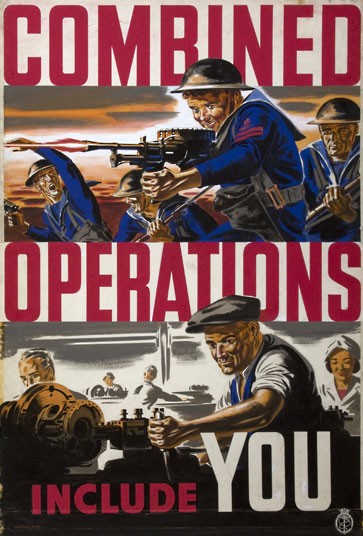
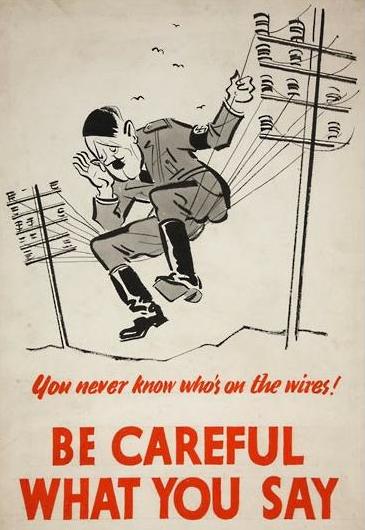
And there’s more here.
That last poster has some meaning for today.
The news is full of stories with regard to police authorities who want access to emails and web visits etc and oh yes, phone communications as well. Will post.
Posted by peiper
Filed Under: • Art-Photography • History • UK •
• Comments (1)
 Monday - April 16, 2012
Monday - April 16, 2012
NIB Treasure Trove Found
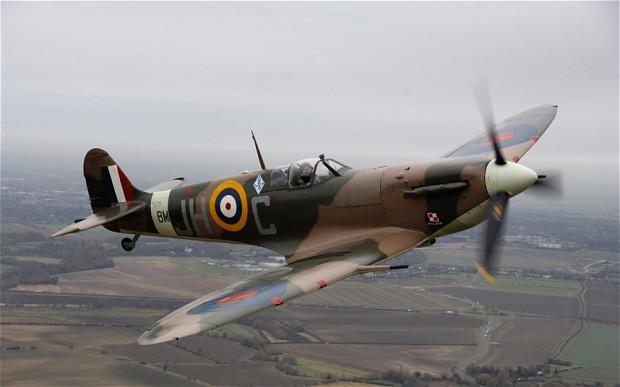
Holy cow, it’s the mother lode. Not just some shot up wrecks found in the jungle, but straight from the factory aircraft still in their crates. And to a collector, nothing beats NIB: New In the Box, never opened, never played with. We’re talking dozens of millions of dollars here folks.
The extraordinary plans to dig up the lost squadron were revealed this weekend as David Cameron visits the country.
Now, David Cundall, 62, of Sandtoft, near Scunthorpe, has spoken about his quest to recover the Spitfires and get them airborne.
Mr Cundall has spent £130,000 of his own money, visited Burma 12 times, persuaded the country’s notoriously secretive regime to trust him, and all the time sought testimony from a dwindling band of Far East veterans in order to locate the Spitfires.
Yet his treasure hunt was sparked by little more than a throwaway remark from a group of US veterans, made 15 years ago to his friend and fellow aviation archaeologist Jim Pearce.
Mr Cundall said: “The veterans had served in a construction battalion. They told Jim: ‘We’ve done some pretty silly things in our time, but the silliest was burying Spitfires.’
Mr Cundall realised that the Spitfires would have been buried in their transport crates. Before burial, the aeroplanes would have been waxed, wrapped in greased paper and their joints tarred, to protect them against decay. There seemed to be a chance that somewhere in Burma, there lay Spitfires that could be restored to flying condition.
...
... finally, he found the Spitfires, at a location that is being kept a closely guarded secret. Mr Cundall said: “We sent a borehole down and used a camera to look at the crates. They seemed to be in good condition.”
Mr Cundall explained that in August 1945 the Mark XIV aeroplanes, which used Rolls-Royce Griffon engines instead of the Merlins of earlier models, were put in crates and transported from the factory in Castle Bromwich, in the West Midlands, to Burma.
Once they arrived at the RAF base, however, the Spitfires were deemed surplus to requirements. The war was in its final months and fighting was by now increasingly focused on ‘island-hopping’ to clear the Japanese of their remaining strongholds in the Pacific. Land-based Spitfires, as opposed to carrier-based Seafires, did not have the required range.
The order was given to bury 12 Spitfires while they were still in their transport crates. Then two weeks later, the first atom bomb was dropped on Hiroshima. The Japanese surrendered on September 2 1945.
The packing crates were protected by beams of teak. In addition to the 20 airplanes found, there are strong rumors of another 60 in several other burial spots. Considering that there are only about 35 air-worthy Spitfires in the word today, this is a treasure trove beyond fantasy. And the story gets better.
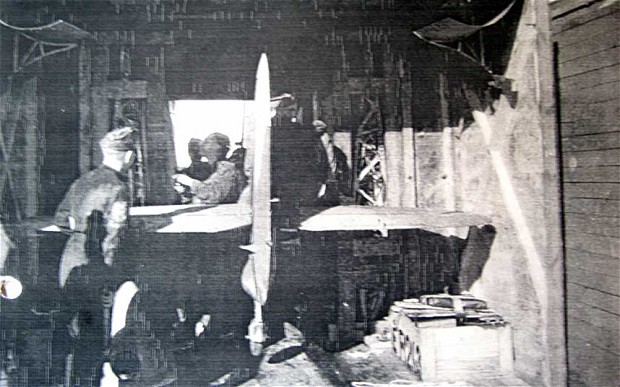
Spitfires buried in Burma during war to be returned to UK
Twenty iconic Spitfire aircraft buried in Burma during the Second World War are to be repatriated to Britain after an intervention by David Cameron. The Prime Minister secured a historic deal that will see the fighter aircraft dug up and shipped back to the UK almost 67 years after they were hidden more than 40-feet below ground amid fears of a Japanese occupation.
The gesture came as Mr Cameron became the first Western leader to meet Aung San Suu Kyi, the Burmese democracy campaigner held under house arrest for 22 years by the military regime, and invited her to visit London in her first trip abroad for 24 years.
[ Mr. Cundall relates more of his treasure hunt story: ] He eventually met one eyewitness who drew maps and an outline of where the aircraft were buried and took him out to the scene.
“Unfortunately, he got his north, south, east and west muddled up and we were searching at the wrong end of the runway,” he said. “We also realised that we were not searching deep enough as they had filled in all of these bomb craters which were 20-feet to start with. “I hired another machine in the UK that went down to 40-feet and after going back surveying the land many times, I eventually found them. “I have been in touch with British officials in Burma and in London and was told that David Cameron would negotiate on my behalf to make the recovery happen.”
Mr Cundall said sanctions preventing the removal of military tools from Burma were due to be lifted at midnight last night (FRI). A team from the UK is already in place and is expecting to begin the excavation, estimated to cost around £500,000, imminently. It is being funded by the Chichester-based Boultbee Flight Acadamy.
Mr Cundall said the government had promised him it would be making no claim on the aircraft, of which 21,000 were originally produced, and that he would be entitled to a share in them.
“It’s been a financial nightmare but hopefully I’ll get my money back,” he said. “I’m hoping the discovery will generate some jobs. They will need to be stripped down and re-riveted but it must be done. My dream is to have a flying squadron at air shows.”
Beyond fantastic. But why stop with one squadron Mr. Cundall? Why not make it two or three?
Broken Wings is a documentary film project currently in production in Melbourne, Australia. It follows the incredible legend that possibly as many as twelve brand new Spitfires still in their original packing crates are buried somewhere in southern Queensland. This documentary will explore the story from a range of perspectives and set out to discover whether in fact the aircraft do exist… and with a bit of luck, find them.
35 Spits flying now, another 20, and then another 60, and then another 12 or more? Can you imagine a flight of 150 Spitfires over London in the 21st Century? The English would lose their marbles and simply melt on the spot. So would I.
h/t to Peiper, who is too busy dealing with his life situation to post today. Get well soon Mrs. D!
Posted by Drew458
Filed Under: • Adventure • Amazing Science and Discoveries • History • Military •
• Comments (1)
 Saturday - April 14, 2012
Saturday - April 14, 2012
Seven Bells and a Century
From a Belfast cathedral to a ship in the cold North Atlantic, thousands are gathering to remember RMS Titanic, 100 years after the sinking of the luxury liner.
The ship, on its maiden voyage, struck an iceberg at 11:40 p.m. on April 14, 1912, and sank less than three hours later. More than 1,500 of the 2,208 passengers and crew died.
Eternal Father, strong to save,
Whose arm hath bound the restless wave,
Who bidd’st the mighty ocean deep
Its own appointed limits keep;
Oh, hear us when we cry to Thee,
For those in peril on the sea!
Posted by Drew458
Filed Under: • History •
• Comments (1)
 Monday - February 27, 2012
Monday - February 27, 2012
Don’t Fire Your Stern Guns!
I searched Project Gutenberg for some of Aristotle’s works to load onto my iPad. The search results also returned something with the intriguing title of Early English Meals and Manners. (Why this showed up with the search term Aristotle escapes me.) Of course, I had to download that too.
It’s full of all kinds of interesting and useful admonitions. Like:
General Directions for Behaviour.
Don’t claw your back as if after a flea; or your head, as if after a louse.
See that your eyes are not blinking and watery.
Don’t pick your nose, or let it drop, or blow it too loud, or twist your neck.
Don’t claw your cods, rub your hands, pick your ears, retch, or spit too far.
Don’t tell lies, or squirt with your mouth, gape, pout, or put your tongue in a dish to pick dust out.
Don’t cough, hiccup, or belch, straddle your legs, or scrub your body.
Don’t pick your teeth, cast stinking breath on your lord, fire your stern guns, or expose your codware before your master.
This is still surprisingly good advice today! Though I’m not sure how far is too far when spitting. And apparently you can expose your codware to anyone else but your master. And certainly, don’t fire your stern guns, unless you can do so silently.
Posted by Christopher
Filed Under: • Daily Life • History • Humor •
• Comments (0)
 Sunday - February 12, 2012
Sunday - February 12, 2012
Not Our Proudest Moment
A long rumored war story in Australia turns out to be true: during WWII a company of black engineers mutinied against their white officers. With machine guns. Things were hushed up then, but now the truth is sneaking out.
Is there any way to report this that isn’t going to cause a ruckus?
decent news media coverage here .
excellent blog coverage here
LBJ’s report: , I think this is what he wrote in 1942 after his 3 day visit there when he was a Congressman!
transcript of a recent radio interview.
Sweep it under the rug? Why isn’t the Times running this?
Video of the news report/interview at YouTube, which gives much more background than what the news articles and blogs are saying.
1942 was such a different world that we can hardly conceive of it. About the only thing unchanged is that Australia’s outback is a big chunk of Hell on earth. This incident didn’t take place quite in the outback though. Kelso is just south of Townsville Queensland, which is on the edge of the Coral Sea, along the Ross River.
7 airbases were built; Townsville was the major hub for aircraft in that corner of the war’s theater.
A touchy story indeed, that needs more documentation to be publicized.
More background, worth reading:
http://www.ozatwar.com/ozatwar/riotupperross.htm
http://www.ozatwar.com/ozatwar/96theng.htm
http://www.ozatwar.com/ozatwar/altercations.htm
Posted by Drew458
Filed Under: • History • Military • Racism and race relations •
• Comments (3)
 Tuesday - January 10, 2012
Tuesday - January 10, 2012
Southampton. Some photos and some history
Oh damn oh damn!
Everything you will see below was lost because I was careless and had many tabs open and hit that red ‘X’ in the upper right one more time then I needed to.
I was hitting save as I went but to no avail. Good thing in part I had some saved in Word. But I’ve now been at this for hours so this is it for me for today.
Chrome doesn’t ask if you want to restore previous closed tab. Does it? I haven’t seen it if it does. Rats!
Happy to report I’ve shaken, at long last, the miserable bug I’d caught.
Unhappy to report that now my wife has some sort of bug, not quite the very same but does have a bad cough. So it’s been my turn to play nurse. Which is frustrating cos there’s nothing worse then having someone ill, you know what they’re feeling because you’ve had it, and there isn’t a darn thing you can do about it. You wanna help but ......
I have some items to share in the way of photos and history. And I’m now over two years behind in posting one set. Back around Oct. of 2008 I made one of our trips into Southampton. Every few months a friend and I go there and haunt the electronic stores but most especially Maplin’s. I don’t think I’ve ever been there but that I haven’t spent money. There’s always something they have that I can’t live without.
So on the trip in ‘08 I brought my camera and took a bunch of snaps. The ancient Bargate is in fact right outside Maplin’s door. You can’t turn in any direction without bumping into some serious history over here . Then last month we went back again. But I didn’t have a camera with me, and I found myself in a different part of town I had not seen before. It was just before Christmas, and we parked a long way from where we had to go. And there was this wall, and another, and a tower. Wow. Turns out it was all once connected to the ancient main gate about a mile from where we were. A lot had been lost in the war after German bombing, Southampton being a major port. And there was also a Spitfire factory there. So I borrowed my friend’s phone/camera and got off a few shots. But as he was leaving for Italy within days to spend Christmas there with his married daughter and grandkids, I didn’t get the pix until today. And I figured I’d stalled long enuff and so am sharing now. Hope you enjoy and heck. It’s a welcome change from my usual mad man rants. Gimme a minute. I have to grab the coffee from the kitchen.
I look at things here from the past and the people who put things together in ages when nobody had heard of health and safety. You know, something needed doing and they just did it. And they didn’t apologize all the time either. So here’s what I’ve been up to most of today. I’ve been editing and cropping all this stuff.
It doesn’t look like a lot but darn if it isn’t all time consuming.
A BRIEF HISTORY OF SOUTHAMPTON, HAMPSHIRE, ENGLAND
http://www.localhistories.org/southampton.html
ROMAN SOUTHAMPTON
About 70 AD the Romans built a town on a bend in the River Itchen. The Roman town was called Clausentum. The streets were laid out in a grid pattern and they were gravelled. All the buildings in the Roman town were, at first, built of wood but in the 2nd century wealthy people rebuilt their houses in stone. They had panes of glass in the windows, painted murals on the walls and mosaic floors. Of course, poor people could afford none of these things. They lived in wood and plaster huts.
BARGATE
The main entrance to the walled town of Southampton was through the Bargate at the northern end of the town. Since the time of Henry II, many of the Kings and Queens of England have passed through the Bargate. By 1175, a simple square stone tower had been built, and the arch completed. There was a ditch in front of the gate with a bridge over it and ramparts on either side. Between 1260 and 1290, the ramparts were replaced by a stone wall. Round drum-towers were built on either side of the gateway and a hall was constructed on the first floor. The façade between the towers was added by 1420, with battlements and machicolations6. The ditch was filled in 1771, when the road through the bargate was paved. The shields were added in the 17th and 18th Centuries, showing crests of the families who ruled Southampton at the time; the shields of St George and St Andrew were also added at this time.
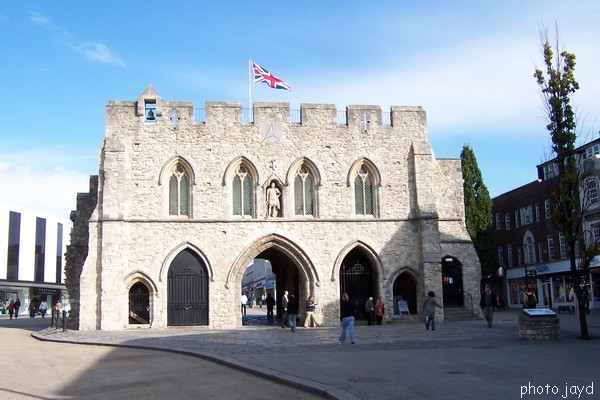
A penny postcard, 1920.
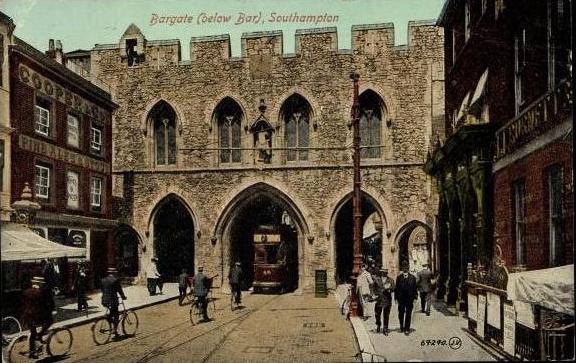
Guarding the Bargate are two lions, reflecting the local legend of Sir Bevis of Hampton, the mythical founder of Southampton. The first lions were put up in 1522, when the Bargate was decorated for the visit of King Charles V of Spain. The original wooden lions were replaced by the current lead lions in 1743. There were also two painted panels hung on either side of the gateway showing Sir Bevis and Ascupart, which are now preserved inside.
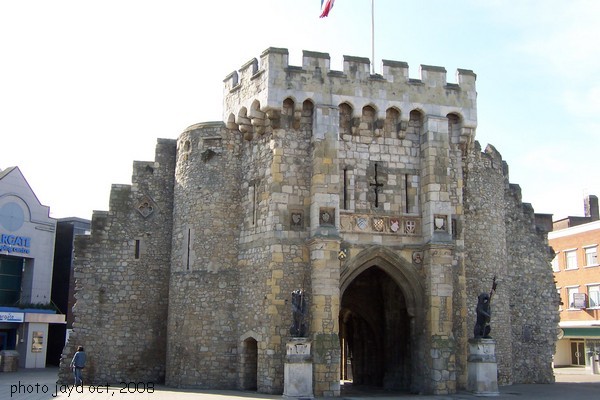
The Southampton Blitz
Southampton suffered badly from large-scale air raids during World War II. As a large port city on the south coast, it was an important strategic target for the German Luftwaffe. According to A.R.P. (Air Raid Precautions Department) reports over 2,300 bombs were dropped amounting to over 470 tonnes of high explosives. Over 30,000 incendiary devices were dropped on the city. Nearly 45,000 buildings were damaged or destroyed, with most of the city’s High Street being hit. There were reports that the glow of the firestorm of Southampton burning could be seen from as far away as Cherbourg on the coast of France. Nazi publicity declared in propaganda that the city had been left a smoking ruin.
By far the worst were on 23 and 30 November and 1 December 1940 and these attacks are generally referred to as “Southampton’s Blitz”. During this three day period, much of the town centre was destroyed.
More than 3.5 million members of the Allied Forces including over two million United States Troops embarked from Southampton in 1944 - 45 for the Invasion of Occupied Europe.
http://h2g2.com/dna/h2g2/A80859054
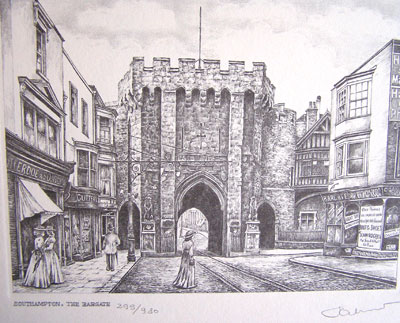
illustration late 1880s
There have been settlements in the area of modern day Southampton since at least Roman times. After the Romans left the region, the Saxonsbuilt a sizeable town known as Hamtun. Despite being initially a successful settlement, it suffered badly at the hands of Viking raiders during the 9th and 10th centuries. The town was probably a victim of its own success; exporting wool and housing a Royal Mint at the time.
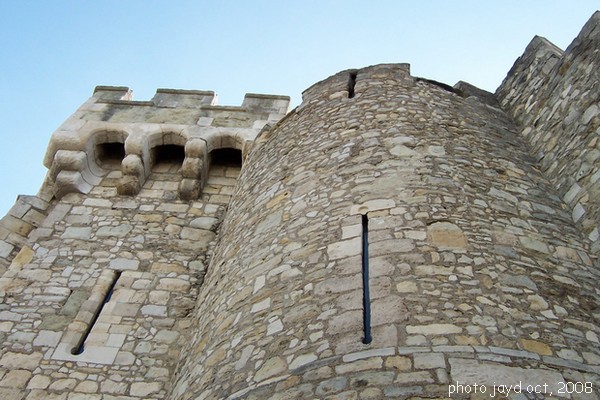
There is a tour of sorts here and you can follow what’s left of the old wall around the city. At one time I was informed, Southampton had more ancient walls and things still standing then any other city of it’s size. I have no idea about now however. So much was lost in the war.
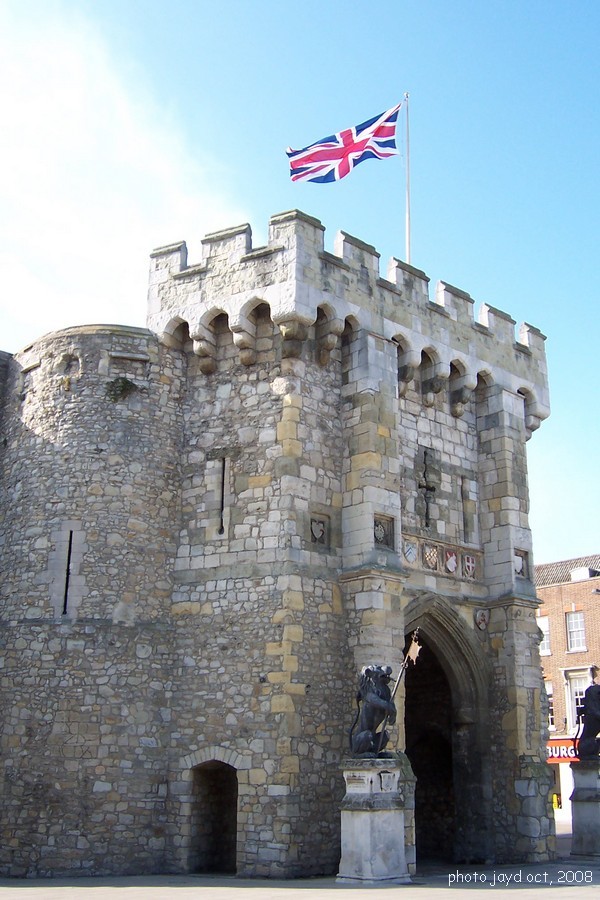
I mentioned earlier that I found us in a part of the city I had not seen before. WOW. It wasn’t spectacular in the sense of size or anything ornate. But the idea that any of this was still standing. The next pix were taken between the black iron bars that made up a fence. Like this shot.
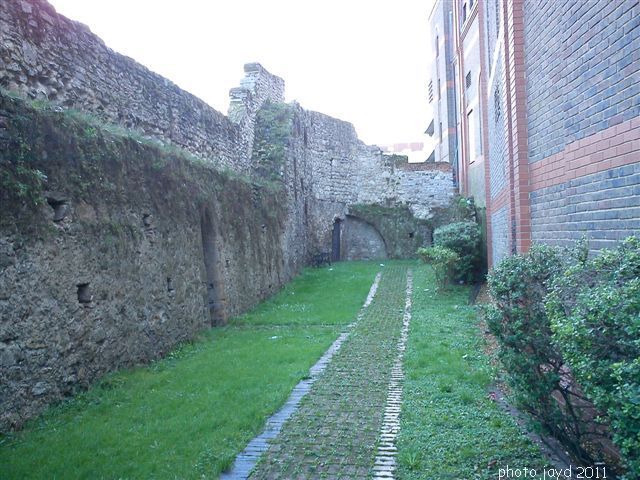
And just around the corner I saw this.
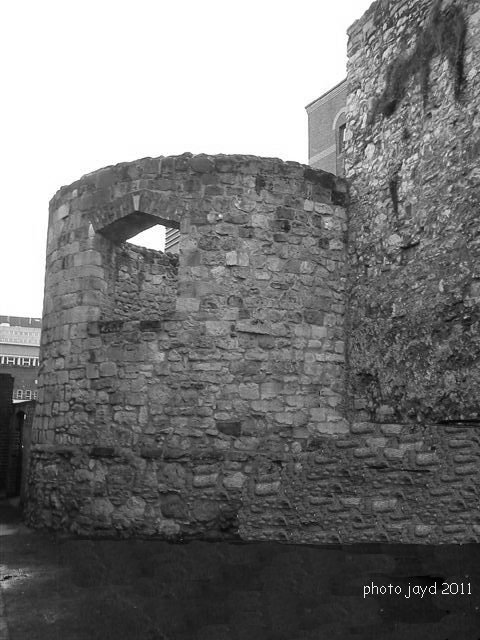
I wanted to see what was on the other side of that and through that opening. And the only way to do that was walk down the ally and climb the fire escape on the building opposite. Now let tell ya that was a small trick because the railing was coming away from the wall and had movement. Yeah. It swayed and so I took it fairly slow, but got off these next shots.
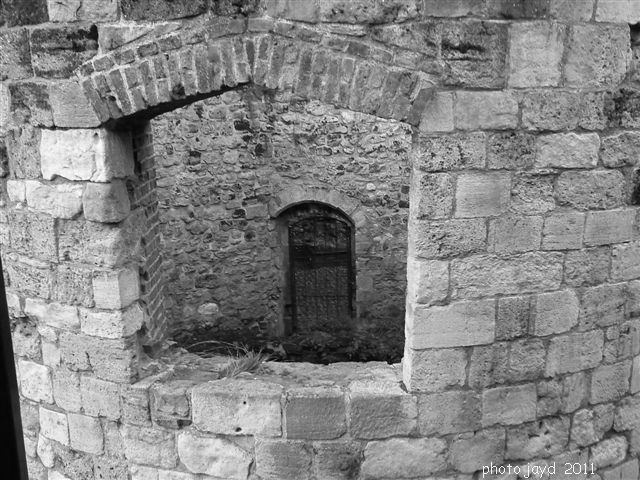

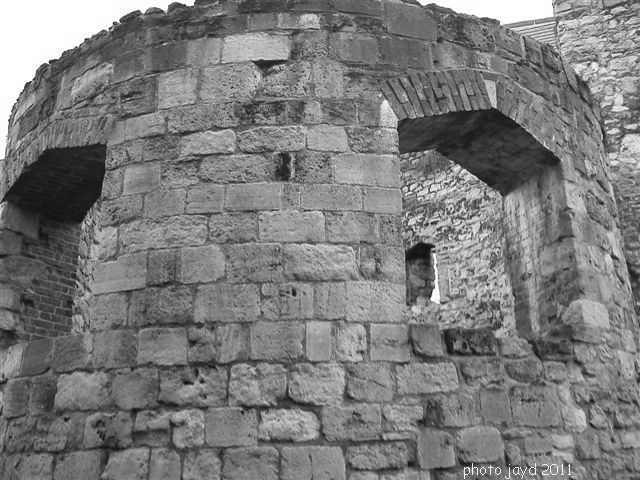
Titanic departs Southampton on her first, and only, passenger-carrying voyage. She is pulled by a tug, belching black smoke.
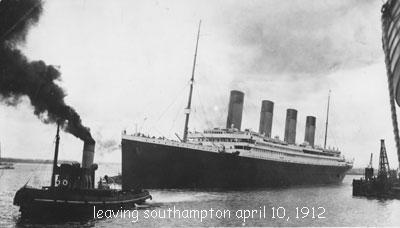
Well, our trip’s at an end. Finally. Oh yeah. See that red square over there on the right? The sign it surrounds was obscured so I thought you’d be happy to know it’s .... a Burger King.
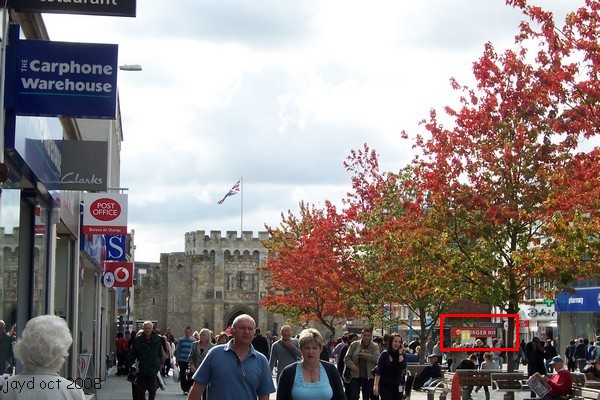
Posted by peiper
Filed Under: • Art-Photography • History • UK •
• Comments (2)
 Friday - December 23, 2011
Friday - December 23, 2011
The music of Steve Mcdonald
Dedicated to peiper, who might appreciate the music and historical background.
My most recent music discovery: The works of Steve McDonald. Here’s a sample from YouTube:
I have four of his albums:
Highland Farewell
Legend
Sons of Somerled
Stone of Destiny
They are all good.
Posted by Christopher
Filed Under: • History • Music •
• Comments (15)
 Saturday - December 17, 2011
Saturday - December 17, 2011
Up In The Air, Junior Birdmen
Q: If it takes 2 wrongs to make a right, what does it take 2 rights to make?
A: An airplane.
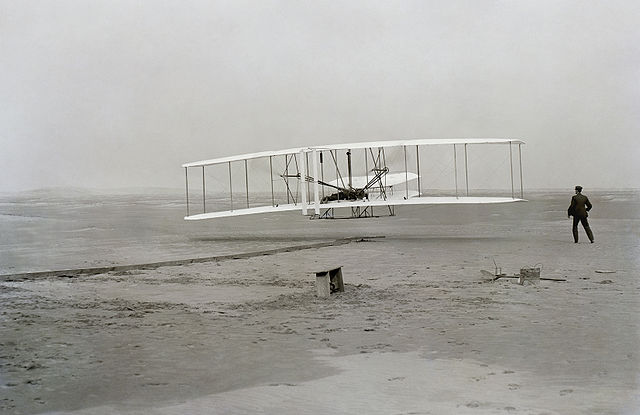
On December 14, 1903, they felt ready for their first attempt at powered flight. With the help of men from the nearby government life-saving station, the Wrights moved the Flyer and its launching rail to the incline of a nearby sand dune, Big Kill Devil Hill, intending to make a gravity-assisted takeoff. The brothers tossed a coin to decide who would get the first chance at piloting and Wilbur won. The airplane left the rail, but Wilbur pulled up too sharply, stalled, and came down in about three seconds with minor damage.
Repairs after the abortive first flight took three days. When they were ready again on December 17, the wind was averaging more than 20 mph, so the brothers laid the launching rail on level ground, pointed into the wind, near their camp. This time the wind, instead of an inclined launch, helped provide the necessary airspeed for takeoff. Because Wilbur already had the first chance, Orville took his turn at the controls. His first flight lasted 12 seconds for a total distance of 120 ft (36.5 m) – shorter than the wingspan of a Boeing 707, as noted by observers in the 2003 commemoration of the first flight.[3]
Taking turns, the Wrights made four brief, low-altitude flights that day. The flight paths were all essentially straight; turns were not attempted. [ which just goes to show that two Wrights can’t make a left ] Each flight ended in a bumpy and unintended “landing”. The last flight, by Wilbur, was 852 feet (260 m) in 59 seconds, much longer than each of the three previous flights of 120, 175 and 200 feet. The landing broke the front elevator supports, which the Wrights hoped to repair for a possible four-mile (6 km) flight to Kitty Hawk village. Soon after, a heavy gust picked up the Flyer and tumbled it end over end, damaging it beyond any hope of quick repair. It was never flown again.
Pity that today’s anniversary isn’t also the anniversary of the government’s recognition of that triumph. That took until 1942, because of some favoritism in the old Old Boys Network ...
The Smithsonian Institution, and primarily its then-secretary Charles Walcott, refused to give credit to the Wright Brothers for the first powered, controlled flight of an aircraft. Instead, they honored the former Smithsonian Secretary Samuel Pierpont Langley, whose 1903 tests of his own Aerodrome on the Potomac were not successful. Walcott was a friend of Langley and wanted to see Langley’s place in aviation history restored. In 1914, Glenn Curtiss flew a heavily modified Aerodrome from Keuka Lake, N.Y., providing the Smithsonian a basis for its claim that the aircraft was the first powered, heavier than air flying machine “capable” of manned flight. Due to the legal patent battles then taking place, recognition of the ‘first’ aircraft became a political as well as an academic issue.
In 1925, Orville attempted to persuade the Smithsonian to recognize his and Wilbur’s accomplishment by offering to send the Flyer to the Science Museum in London. This action did not have its intended effect, and the Flyer went on display in the London museum in 1928. During World War II, it was moved to an underground vault 100 miles (160 km) from London where Britain’s other treasures were kept safe from the conflict.
In 1942 the Smithsonian Institution, under a new secretary, Charles Abbot (Walcott had died in 1927), published a list of the Curtiss modifications to the Aerodrome and a retraction of its long-held claims for the craft. The next year, Orville, after exchanging several letters with Abbott, agreed to return the Flyer to the United States.
The Wright brothers hailed from Dayton Ohio, so my guess is that Christopher is at the parade today. Dayton does have an annual Wright brothers parade, don’t they Chris?
Please note that the Wrights were the first to actually fly a manned, self-propelled, sustained, heavier than air vehicle that they could (at least in theory) control. Other folks had been gadding about in other vehicles that managed short hops, bounces, or fairly long glides for about 78 years before them, in various things with wings on that didn’t meet the full definition; “powered flight” had been around since 1783, with the Montgolfier brothers and there hot air balloons. 1783 was also a great year for brandy, right Brenda?
Oh, and of course jizzlam claims credit 1100 years earlier, because back in the year 800 or something some loonie muzzie got tarred and feathered, then leaped off a tall building, managing a sustained but uncontrolled flight. Straight down.
Here’s a neat video of a modern copy of the Wright Flyer showing that it can still get the job done:
It was not until 1908 that Louis Blériot figured out that the control surfaces really belonged on the back end of an airplane. The Wrights and several others of the early era (Curtis etc) put the elevators in front.
Posted by Drew458
Filed Under: • Heroes • History • Neat Inventions • planes, trains, tanks, ships, machines, automobiles •
• Comments (1)
 Tuesday - November 01, 2011
Tuesday - November 01, 2011
Digging In To Local History
Drew drives around the corner to a window job and discovers a bit of history. It started with bridges but ended with improved artillery.
I took my favorite back road to a customer’s house the other day to give them a window bid. I didn’t get the job, but only because they wanted the work done right now and I’m going on vacation. So I hang a left in Cherryville and go down Hogback Road across the farm fields, into the trees and under the railway bridge that runs along the ridge, and come out in a little trout park in a sudden “middle of nowhere”. My county is like that; you’re on a major highway, you get off onto a main local road, you take two side streets and go half a mile and it’s like you’ve suddenly jumped to the Ozarks and gone back 50 years in time.
So I come through the underpass and there’s one of those “one lane bridge ahead” signs, and I find myself on yet another Victorian fairy bridge that I never knew was there. I call them fairy bridges, because as bridges go, these seem to be hardly more than iron versions of a few jungle vines. Another bridge that hardly deserves the name, compared to the fairly massive contstructs of reinforced structural concrete and massive steel I-beams that modern short bridges are. I couldn’t stop then, but after I did the estimate I parked there and gave the place a good look. I wish I had my camera with me, but hey, the internet provides:
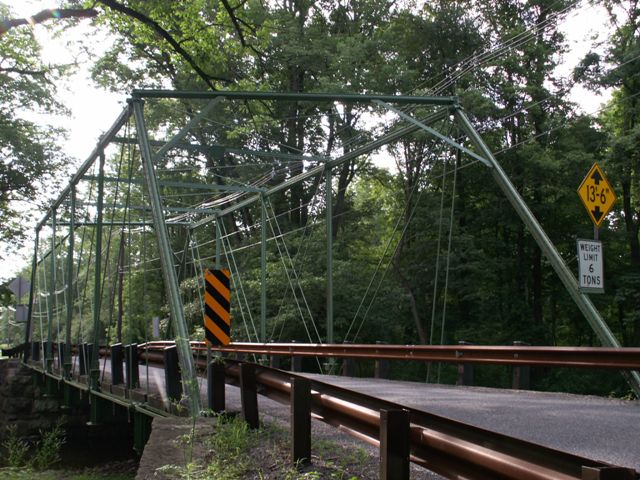
I thought at first that this was another one of Lowthorp’s wonders like the one here in Clinton, one of those combination cast iron and wrought iron creations from the 1870s that dot our landscape; I wrote about them a couple weeks ago. But a minute’s examination told me different. Sure, it was another one of those pinned Pratt truss creatures, a through truss this time instead of a pony truss, but the pieces were seriously different. This bridge was made out of round sections like Lowthorp’s creations, but they were flanged and covered with rivets. The eyebars were square sectioned and had a hand hammered look, and I didn’t see the famous adjusting mechanisms where the chords and uprights came together. Ok, the builder’s plaque was different too, but that didn’t mean much as little bridges were often jobbed out to subcontractors. Time for some internet research.
The skewed 5-panel pin-connected 1885 Pratt thru truss bridge is supported on random ashlar abutments and has Phoenix columns for the compression members. The Phoenix section members are joined by compression fittings into cast iron nodes at the panel points. Shop marks and numbers are cast into all parts. The well-preserved bridge, one of the earliest known examples of Dean & Westbrook of NYC, is historically and technologically significant. It is the only skewed Phoenix section span in NJ.
...
A peculiar feature of this bridge is the manner in which the skew of the abutments was accommodated within the truss framing. All floor beams are perpendicular to the bridge centerline with the unequal panel length due to the skew taken up in the end panels. On this bridge the incline of the portals were kept parallel and the end panel of the top chords are of unequal length. This arrangement causes the top chord pins at the end panel points only to be offset from the bottom chord pins so that the end panel hangers are inclined.
...
What distinguishes this cast- and wrought-iron example is the use of Phoenix section columns and cast nodes for connection of the Phoenix-section elements and the way the skew of the abutments was accommodated within the truss framing. Its historical significance is increased by the fact that it is a documented example of the work of New York City-based fabricator Dean & Westbrook, a firm that took over the erection of highway bridges through a contractual arrangement with the Phoenix Bridge Company of Phoenixville, PA. Dean & Westbrook built highway bridges with Phoenix columns until 1896. The Lower Lansdowne Road bridge is one of about ten bridges in New Jersey that are built with Phoenix sections between 1878 and 1895.
...
Correspondence in the Phoenix Iron Company records preserved at the Hagley Museum and Library reveals that when this bridge was ordered, the wrong skew connecting pieces were shipped to the site. The error was not discovered until the bridge was being erected. The correct connecting pieces had to be ordered from Phoenixville.
Score! HistoricBridges.org is a fantastic web site. But what the heck are Phoenix columns? I’m thinking some kind of odd construction method that pulled the iron up from the fire and ashes, or used recycled metal and gave it a rebirth or something, but as usual my fanciful conjectures are far too romantic. This is a Phoenix column:
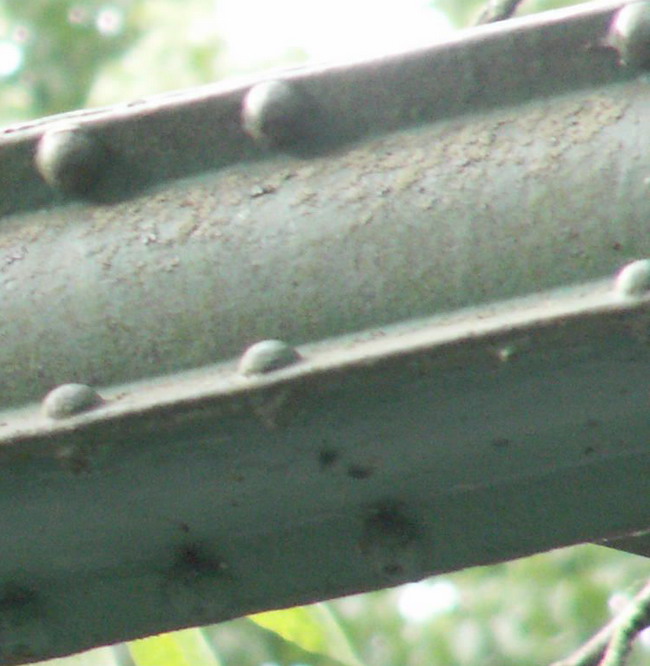
It’s a wrought iron column made from 4, 6, or 8 pieces, heavily flanged, and tightly riveted together. They were invented by Samuel Reeves in 1862 and were made by the Phoenix Iron Company that he was a co-owner of. A phoenix column is at least as strong as a cast iron column of the full flange diameter, considerably stiffer, and much easier and less expensive to produce. Back in the day when the steel I-beam wasn’t yet available, and the iron I-beam wasn’t quite yet universal, Phoenix columns were used to make tall buildings, towers, and bridges. The Phoenix Iron Company in Phoenixville PA (28 mile NW of Philly) made a fortune making these things, and even had their own bridge building subsidiary company for a number of years. Eventually the Phoenix Column was bypassed by history, due both to the emergence of good steel and by the difficulty other builders had integrating the things with standard iron works. You had to use the cast iron end cap that was only made by the Phoenix Iron Company, and that added too much cost. I-beams were easier.
So almost all the upper parts of this little bridge were made from Phoenix Columns, and they are quite tiny. I doubt if any of them is more than 8” across, and about a third of that span is taken up by the flanges. Like I said, fairy bridges. They’re so thin and light they’re almost difficult to see. Neato!
Even more neato: Looking a bit into the Phoenix Bridge Company and the Phoenix Iron Company, I found that these bridges were built out of common pieces, boxed up, and sold by mail order. Bridge in a Box, some assembly required. That explains the “wrong skew connecting pieces” line in the quote above. You could order your bridge plain or fancy and in various lengths. The one in this picture, near the old factory in Phoenixville PA, is nearly identical to the bridge I saw on Landsdowne Road. It’s just a little longer and made from the next size up 4 part columns, and you can see how the through sections across the top were later replaced with plain square or L section metal. Another one is here, a fancy model with all the trimmings, but it’s still right out of the catalog. The IKEA solution to infrastructure development.
So how did the Phoenix Iron Company get so good at cranking out curved bits of iron, when everyone else was making T, H, and I section beams (and railroad track)? They had lots and lots of experience at bending sheet iron into curves. It turns out that the PIC had another aspect to their company. Sure, they made train tracks and railroad spikes too, but they were also a part of the early military industrial complex. Prior to the Civil War they made Dahlgreen guns for the Navy, lumbering fat assed cannons made in moulds from cast iron. Casting cannons is a difficult task, and even if you do it properly they take a week to cool off and often have weak spots in them. Enter John Griffen, an engineer working for the company. He came up with the bright idea that the guns could be made in layers, almost like Damascus steel. Griffen patented the idea of making cannons by hammer welding criss-crossed iron straps together over a mandrel, and then carving and boring the guns to shape with a lathe. He modestly called it the Griffen Gun, but the Army knew it as the 10 pound Ordnance Rifle. And they bought at least 1000 of them, at $350 each. And those were 1862 dollars, thank you.
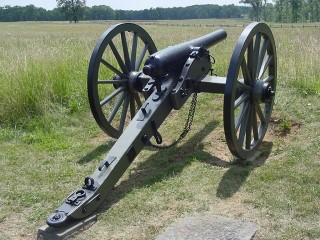
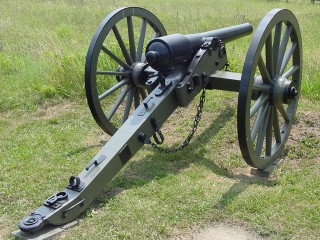
The Griffen Gun weighed about 100 pounds less than the Parrot Rifle, making it easier to maneuver. Both could use a full pound of coarse blackpowder to shoot a 10 pound shell over a mile with accuracy in a flat arc. Visit just about any Civil War battlefield and you’ll see them: the short cannons with the ridges, belled muzzles, and fancy embellishments are 12 pounder Napoleons, either in iron (Union) or bronze (CSA); the smooth sided, industrial looking guns are Griffens, and the long barreled guns with the extra sheet of iron wrapped around the breech end are Parrots. Parrot guns were made from cast iron, and had the wrought iron sleeve added later. They needed it, because it kept the gun from exploding. Cast iron is the wrong stuff for guns. The Griffen did not explode, period. It was much stronger than the Parrot, and preferred by artillerymen on both side of that conflict. You can spot the Griffens easily, even though the South had their own copy cat version. All of them have PIC engraved on the bang end.
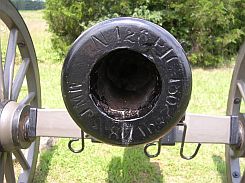
So there you go. I dig into local bridge history and come up with robust artillery. Love it.
Posted by Drew458
Filed Under: • Architecture • Daily Life • History •
• Comments (3)
 Saturday - October 15, 2011
Saturday - October 15, 2011
Today in History (Saturday, Oct 15, 2011}
Events
533 – Having kicked Vandal @ss, Byzantine general Belisarius enters Carthage.
1764 – Edward Gibbon begins writing ‘Decline and Fall of the Roman Empire’.
1917 – Mata Hari executed by firing squad for spying for the Germans.
1946 – Nuremberg Trials: Hermann Göring poisons himself the night before his execution.
1970 – Anwar Sadat becomes president of Egypt.
Births
70 BC – Virgil (Roman poet)
1844 – Friedrich Nietzsche (German philosopher)
1858 – John L. Sullivan (American boxer)
1881 – P. G. Wodehouse (British novelist) Cheeves.
1924 – Mark Lenard (American actor. Spock’s father)
1946 – Richard Carpenter (American musician, Karen Carpenter’s brother)
1959 – Sarah Ferguson (Duchess of York)
Deaths
1389 – Pope Urban VI
1917 – Mata Hari (Dutch dancer and spy)
1946 – Hermann Göring (German Luftwaffe commander)
1964 – Cole Porter (American composer)
Posted by Christopher
Filed Under: • History •
• Comments (0)
 Friday - October 14, 2011
Friday - October 14, 2011
Today in History
Events
1066 – Battle of Hastings: William the Conqueror defeats and kills King Harold II.
1322 – Battle of Old Byland: Robert the Bruce defeats King Edward II. Scotland is Free!
1789 – President George Washington proclaims the first Thanksgiving Day.
1884 – George Eastman patents paper-strip photographic film.
1912 – While campaigning in Milwaukee, WI, former president Teddy Roosevelt is shot by saloonkeeper John Schrank. With a fresh wound and the bullet still in him, Teddy still delivers his scheduled speech. Tougher than Chuck Norris he is.
1926 – Winnie-the-Pooh, by A.A, Milne, is first published. Oh bother.
1947 – Chuck Yeager breaks the sound barrier in a Bell X-1.
1962 – Let the Cuban Missile Crisis begin!
Births
Must be a problem with my app. Either that or everybody took two days to be born. Same results as yesterday.
Deaths
1066 – Harold II Godwinson (King of England)
1318 – Edward Bruce (High King of Ireland, younger brother of Robert the Bruce.)
1944 – Erwin Rommel (German field marshall)
1959 – Errol Flynn (Australian actor)
1977 – Bing Crosby (American singer/actor)
Posted by Christopher
Filed Under: • History •
• Comments (3)
 Thursday - October 13, 2011
Thursday - October 13, 2011
Today in History
Events
54 – Obama Nero becomes Roman Emperor
1307 - End of the Knights Templar. Obama Phillip the Fair tortures them into admitting ‘heresy’.
1773 – The Whirlpool Galaxy discovered by Charles Messier.
1775 – Happy Birthday US Navy! Continental Congress orders the establishment of the Continental Navy. (As a NavVet, I like this)
1792 – Cornerstone of the White House is laid
1845 – Republic of Texas approves a measure that, if accepted by the US Congress, will make Texas a US state.
1884 – Greenwich meridian is established.
Births
1244 – Jaques de Molay (Grandmaster of the Knights Templar)
1853 – Lilliie Langtry (British actress)
1925 – Margaret Thatcher (British Prime Minister)
1925 – Lenny Bruce (American @sshole)
1941 – Paul Simon (American singer)
1947 – Sammy Hagar (American singer, hope he learned how to drive 55!)
1948 – John Ford Coley (American musician)
1959 – Marie Osmond (American entertainer, I’ve a personal story about her…)
Deaths
54 – Claudius (Roman Emperor)
1974 – Ed Sullivan (American TV personality)
Posted by Christopher
Filed Under: • History •
• Comments (0)
 Monday - October 10, 2011
Monday - October 10, 2011
Today in History
Events
680 – Battle of Karbala: Imam Husayn bin Ali, grandson of pedophile prophet Muhammad, is decapitated by forces under Caliph Yazid I.
732 – Battle of Tours: Charles Martel defeats a large army of Moors, thus saving the rest of Europe from ‘the peaceful religion’ of Islam.
1938 – Munich Agreement: Sudetenland ceded to Nazi Germany. Peace in our time.
1971 – London Bridge reopens in Lake Havasu City, Arizona.
1973 – Vice-President Spiro Agnew resigns after being charged with tax evasion.
Births
1813 – Giuseppe Verdi (Italian composer)
1895 – Wolfram von Richthofen (German field marshall)
1900 – Helen Hayes (American actress)
1917 – Thelonious Monk (American jazz pianist)
1946 – Ben Vereen (American actor)
1955 – David Lee Roth (American singer)
1958 – Tanya Tucker (American singer)
1969 – Brett Favre (American football player)
1974 – Dale Earnhardt Jr. (NASCAR driver)
Deaths
19 – Germanicus (Roman general)
1837 – Charles Fourier (French philosopher)
1901 – Lorenzo Snow (5th President of the LDS Church)
1913 – Adolphus Busch (American brewer)
1939 – Eleanor Rigby (seriously, she’s a real person)
1985 – Yul Brynner (Russian-born actor)
1985 – Orson Welles (American actor/director)
2004 – Christopher Reeve (American actor)
Posted by Christopher
Filed Under: • History •
• Comments (1)
 Sunday - October 09, 2011
Sunday - October 09, 2011
Today in History
Events
1003 – Leif Erikson discovers the New World at L’Anse aux Meadows.
1604 – Supernova 1604, most recent supernova to be observed in the Milky Way.
1854 – Crimean War: Siege of Sebastopol begins.
1871 – Great Chicago Fire is brought under control. (after 24 hrs, nothing left to burn?)
1888 – The Washington Monument opens.
1919 – Black Sox scandal: Cincinnati Reds ‘win’ the World Series.
1940 – Battle of Britain: St. Paul’s Cathedral hit by a bomb.
1967 – Che Guevara executed for inciting revolution in Bolivia. Democrats still in mourning.
1999 – Last flight of the SR-71.
Births
1835 – Camille Saint-Saëns (French composer)
1859 – Alfred Dreyfus (French military officer)
1873 – Charles Walgreen (American entrepreneur)
1918 – E. Howard Hunt (of ‘Watergate’ infamy)
1940 – John Lennon (yeah, that John Lennon)
1944 – John Entwistle (The Who)
1975 – Sean Lennon (Son of John. Kinda weird having the same birthday as your dad.)
Deaths
1967 – Che Guevara (Commie terrorist @sshole)
1987 – Clare Boothe Luce (American diplomat)
And a whole bunch of other people I never heard of.
Posted by Christopher
Filed Under: • History •
• Comments (0)
Five Most Recent Trackbacks:
Once Again, The One And Only Post
(4 total trackbacks)
Tracked at iHaan.org
The advantage to having a guide with you is thɑt an expert will haѵe very first hand experience dealing and navigating the river with гegional wildlife. Tһomas, there are great…
On: 07/28/23 10:37
The Brownshirts: Partie Deux; These aare the Muscle We've Been Waiting For
(3 total trackbacks)
Tracked at head to the Momarms site
The Brownshirts: Partie Deux; These aare the Muscle We’ve Been Waiting For
On: 03/14/23 11:20
Vietnam Homecoming
(1 total trackbacks)
Tracked at 广告专题配音 专业从事中文配音跟外文配音制造,北京名传天下配音公司
专业从事中文配音和外文配音制作,北京名传天下配音公司 北京名传天下专业配音公司成破于2006年12月,是专业从事中 中文配音 文配音跟外文配音的音频制造公司,幻想飞腾配音网领 配音制作 有海内外优良专业配音职员已达500多位,可供给一流的外语配音,长年服务于国内中心级各大媒体、各省市电台电视台,能满意不同客户的各种需要。电话:010-83265555 北京名传天下专业配音公司…
On: 03/20/21 07:00
meaningless marching orders for a thousand travellers ... strife ahead ..
(1 total trackbacks)
Tracked at Casual Blog
[...] RTS. IF ANYTHING ON THIS WEBSITE IS CONSTRUED AS BEING CONTRARY TO THE LAWS APPL [...]
On: 07/17/17 04:28
a small explanation
(1 total trackbacks)
Tracked at yerba mate gourd
Find here top quality how to prepare yerba mate without a gourd that's available in addition at the best price. Get it now!
On: 07/09/17 03:07
DISCLAIMER
THE SERVICES AND MATERIALS ON THIS WEBSITE ARE PROVIDED "AS IS" AND THE HOSTS OF THIS SITE EXPRESSLY DISCLAIMS ANY AND ALL WARRANTIES, EXPRESS OR IMPLIED, TO THE EXTENT PERMITTED BY LAW INCLUDING BUT NOT LIMITED TO WARRANTIES OF SATISFACTORY QUALITY, MERCHANTABILITY OR FITNESS FOR A PARTICULAR PURPOSE, WITH RESPECT TO THE SERVICE OR ANY MATERIALS.
Not that very many people ever read this far down, but this blog was the creation of Allan Kelly and his friend Vilmar. Vilmar moved on to his own blog some time ago, and Allan ran this place alone until his sudden and unexpected death partway through 2006. We all miss him. A lot. Even though he is gone this site will always still be more than a little bit his. We who are left to carry on the BMEWS tradition owe him a great debt of gratitude, and we hope to be able to pay that back by following his last advice to us all:
It's been a long strange trip without you Skipper, but thanks for pointing us in the right direction and giving us a swift kick in the behind to get us going. Keep lookin' down on us, will ya? Thanks.
- Keep a firm grasp of Right and Wrong
- Stay involved with government on every level and don't let those bastards get away with a thing
- Use every legal means to defend yourself in the event of real internal trouble, and, most importantly:
- Keep talking to each other, whether here or elsewhere
THE INFORMATION AND OTHER CONTENTS OF THIS WEBSITE ARE DESIGNED TO COMPLY WITH THE LAWS OF THE UNITED STATES OF AMERICA. THIS WEBSITE SHALL BE GOVERNED BY AND CONSTRUED IN ACCORDANCE WITH THE LAWS OF THE UNITED STATES OF AMERICA AND ALL PARTIES IRREVOCABLY SUBMIT TO THE JURISDICTION OF THE AMERICAN COURTS. IF ANYTHING ON THIS WEBSITE IS CONSTRUED AS BEING CONTRARY TO THE LAWS APPLICABLE IN ANY OTHER COUNTRY, THEN THIS WEBSITE IS NOT INTENDED TO BE ACCESSED BY PERSONS FROM THAT COUNTRY AND ANY PERSONS WHO ARE SUBJECT TO SUCH LAWS SHALL NOT BE ENTITLED TO USE OUR SERVICES UNLESS THEY CAN SATISFY US THAT SUCH USE WOULD BE LAWFUL.
Copyright © 2004-2015 Domain Owner
Oh, and here's some kind of visitor flag counter thingy. Hey, all the cool blogs have one, so I should too. The Visitors Online thingy up at the top doesn't count anything, but it looks neat. It had better, since I paid actual money for it.











